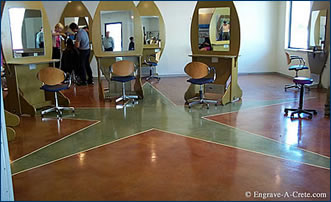Although stain is permanent and won't flake off like paint, it penetrates only the top layer of the concrete surface and will eventually wear away as the surface is worn by traffic or weather exposure. To prolong stain life, stain manufacturers recommend keeping stained surfaces protected with multiple coats of clear sealer (outdoors) and a floor wax (indoors).
A good sealer will provide other benefits as well, such as adding sheen to the surface and enhancing color intensity. (See Protecting Acid Stained Floors and The Concrete Network's Shop Smart Guide to Buying Concrete Sealers.)
Find a contractor that specializes in staining and sealing concrete near me or buy concrete sealers to do the project yourself.
Sealing Stained Concrete Floors
Many homeowners seal their stained floors themselves. Here's a step-by-step summary of how to seal concrete. Be sure not to use an etching solution on stained concrete.
If you're trying to find the best sealer for stained concrete floors, here's a breakdown of the different types:
Acrylic Sealers: Acrylics are UV stable, affordable, and easy to apply or reapply, as necessary. They also offer a wet look that greatly enriches the appearance of stained finishes. The downside is that they have the softest surface of all the sealer types and require the most maintenance. One coat of a solvent-based acrylic sealer followed by a topcoat of a water-based acrylic will provide ample protection for interior stain applications. Future floor maintenance can be completed with additional coats of water-based acrylic sealers or waxes as needed.
Epoxy Sealers: If your stained floor is high traffic, such as a restaurant or other public space, an epoxy sealer may be a good option. Epoxies are harder than acrylics, but don’t allow trapped moisture to escape which may become a problem later. When sealing with an epoxy, thorough moisture testing is a must. Epoxy sealers are popular for stained countertops.
Urethane Sealers: This sealer type is the most expensive, but also the most abrasive-resistant. To get a proper bond, urethanes must be applied over a water-based epoxy. You also should be aware that they are not UV stable.
View this comparison chart of concrete sealers. Get information about how they work, primary applications, type of finish, and performance about each type.
Sealing Stained Concrete Patios & More
Acrylic sealers are best for outdoor stain applications because they allow moisture in the slab to escape. Many contractors prefer solvent-based acrylics over water-based acrylics because they tend to perform better outside. If the shiny or wet look is not desired, silicone-based penetrating sealers are recommended for a matte finish.
To keep exterior stained surfaces protected, apply a new coat of sealer every year or two, or as necessary. When you begin to notice that water no longer beads up on the surface, it's time to reseal.





